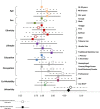The epidemiology of chronic kidney disease in Northern Tanzania: a population-based survey
- PMID: 25886472
- PMCID: PMC4401757
- DOI: 10.1371/journal.pone.0124506
The epidemiology of chronic kidney disease in Northern Tanzania: a population-based survey
Abstract
Background: In sub-Saharan Africa, kidney failure has a high morbidity and mortality. Despite this, population-based estimates of prevalence, potential etiologies, and awareness are not available.
Methods: Between January and June 2014, we conducted a household survey of randomly-selected adults in Northern Tanzania. To estimate prevalence we screened for CKD, which was defined as an estimated glomerular filtration rate ≤ 60 ml/min/1.73m2 and/or persistent albuminuria. We also screened for human immunodeficiency virus (HIV), diabetes, hypertension, obesity, and lifestyle practices including alcohol, tobacco, and traditional medicine use. Awareness was defined as a self-reported disease history and subsequently testing positive. We used population-based age- and gender-weights in estimating prevalence, and we used generalized linear models to explore potential risk factors associated with CKD, including living in an urban environment.
Results: We enrolled 481 adults from 346 households with a median age of 45 years. The community-based prevalence of CKD was 7.0% (95% CI 3.8-12.3), and awareness was low at 10.5% (4.7-22.0). The urban prevalence of CKD was 15.2% (9.6-23.3) while the rural prevalence was 2.0% (0.5-6.9). Half of the cases of CKD (49.1%) were not associated with any of the measured risk factors of hypertension, diabetes, or HIV. Living in an urban environment had the strongest crude (5.40; 95% CI 2.05-14.2) and adjusted prevalence risk ratio (4.80; 1.70-13.6) for CKD, and the majority (79%) of this increased risk was not explained by demographics, traditional medicine use, socioeconomic status, or co-morbid non-communicable diseases (NCDs).
Conclusions: We observed a high burden of CKD in Northern Tanzania that was associated with low awareness. Although demographic, lifestyle practices including traditional medicine use, socioeconomic factors, and NCDs accounted for some of the excess CKD risk observed with urban residence, much of the increased urban prevalence remained unexplained and will further study as demographic shifts reshape sub-Saharan Africa.
Conflict of interest statement
Figures



References
-
- United Nations Office of the Secretary General. Report on the prevention and control of non-communicable diseases: follow-up of 19th UNAIDS Conference; 2011. Available: http://www.un.org/en/ga/president/65/issues/ncdiseases.shtml. Accessed 13 August 2014.
-
- Fuster V.Cardiovascular disease and the United Nation Millennium Development Goals: a serious concern. Nature Clin Pract Cardiovasc Med. 2006; 3(8):401 - PubMed
-
- Daar AS, Singer PA, Persad DL, Pramming SK, Matthews DR, Beaglehole R, et al.Grand challenges in chronic non-communicable diseases. Nature. 2007; 450: 494–6. - PubMed
-
- Central Census Office and National Bureau of Statistics. United Republic of Tanzania: 2012 Population and Housing Census; 2013. Available: http://www.nbs.go.tz. Accessed 20 Sept 2014.
Publication types
MeSH terms
Grants and funding
LinkOut - more resources
Full Text Sources
Other Literature Sources
Medical

